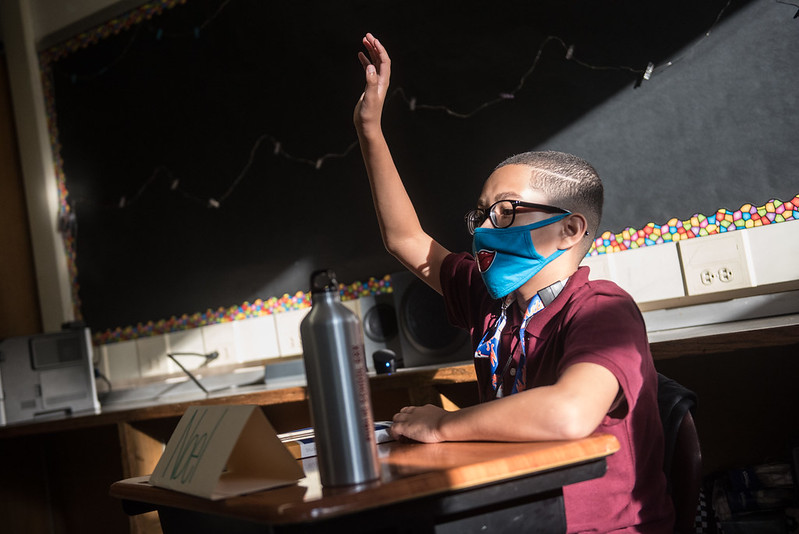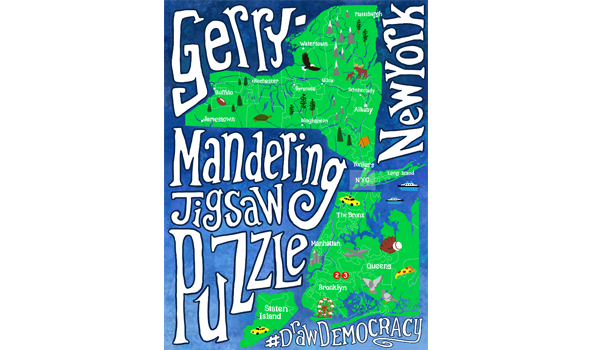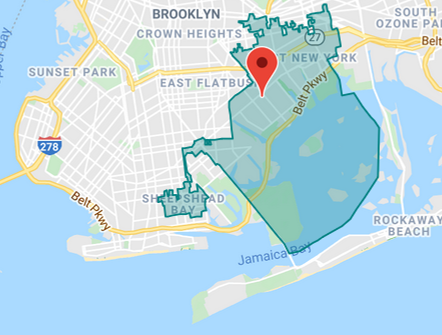Addressing the Rise in Mental Health Challenges Among Hispanic Youth

Students at school (photo: Michael Appleton/Mayoral Photography Office)
Young people are often uncomfortable asking for help. Now imagine there is a language barrier as well. Children, teens, and young adults are currently battling social isolation, loneliness, and mental illness in increasing numbers, and the language barrier greatly exacerbates this for Spanish-speaking youth and their families.
Access to mental health services has traditionally been lower for this community. More than half of Hispanic young adults ages 18-25 with serious mental illness may not receive treatment, according to the National Alliance on Mental Illness, (NAMI). The organization also reported that approximately 34% of Hispanic adults with mental illness receive treatment each year compared to the United States average of 45%.
Right now, there is a shortage of mental health providers in the U.S., regardless of language, and more so of bilingual mental health providers. USA Facts estimates that an additional 6,398 mental health providers, including psychiatrists, social workers, and therapists are needed to fill in the gaps. At Astor Services for Children & Families, we are feeling that lack acutely given that we work with a high percentage of Spanish-speaking families in our out-patient programs in the Bronx.
For the first time in my 13-plus years at Astor, we had to suspend intakes. We simply did not have enough clinicians, particularly in our out-patient clinics, to provide the level of care that’s needed for this population. We must make sure everyone is getting quality service, and we can only do that if we have the right family-to-clinician caseload ratio.
While we are coming out of the pandemic, our children and families still require an increased level of care and support. Clients who were socially isolated are coming to us with multiple diagnoses; for example, they may come in with depression and then also be diagnosed with anxiety and post-traumatic stress. We are also seeing widespread trauma and anxiety about returning to in-person school. Many of our families also have multiple stressors around the economy and employment.
As we continue to assess needs and prioritize the most critical cases on our wait-list, how can we best address this shortage of caregivers across our industry and better serve our community? The first solution is to be able to hire more bilingual family advocates. A family advocate provides strong support to a family, and many can be high school graduates. If the city provided funding for mental health non-profits, including Astor, to be able to hire more family advocates, they could be that bridge between the family and the mental health provider until they are ready to support them with a licensed clinician.
New York City is looking to hire 500 social workers over a three-year period. However, the city should not be in the business of hiring social workers; and must leave that to the experts in the field and who are already helping the city’s youth deal with their mental health challenges and emotional needs every day.
Let us do the work and collaborate with the schools. Astor already works in 35 schools in the Bronx, so it makes most sense that the city should step back and provide Astor and all agencies that are already working with mental health the funding to do what we are the experts at, for the greatest good of the youth.
With trust and critical funds, mental health nonprofits across the city can do what they do best. In fact, by investing in the support and care of all our youth today, we are paving the way for a better and more hopeful and healthy future.
***
Yvette Bairan is Chief Executive Officer at Astor Services for Children & Families. On Twitter @AstorServices.
***
Have an op-ed idea or submission for Gotham Gazette? Email This email address is being protected from spambots. You need JavaScript enabled to view it.
New York Gerrymandering: When the Puzzle Pieces Don’t Fit

The #DrawDemocracy NY gerrymandering jigsaw puzzle
The 2020 Census data is out, and redistricting of legislative boundaries has officially begun. While state leaders should see the new data as a chance to understand how New York’s changing communities can be better represented, historically, our elected officials have used redistricting to favor themselves and special interests. It’s time for this tradition to end -- New Yorkers cannot wait another decade for fair representation.
To show New Yorkers just how ugly our state’s gerrymandering is, the #DrawDemocracy campaign has developed what we believe to be the first-ever Gerrymandering Jigsaw Puzzle based on electoral districts – in this case, the New York State Senate (yes, you can get one for yourself).
The New York State Senate’s lines were drawn by Republicans as part of a power-sharing agreement with Democrats, who were allowed to draw their own Assembly districts. One reason both parties maintained such strong grips on their respective chambers for so long is gerrymandering.
Since the Democrats now have a supermajority in both houses, the power-sharing agreement no longer exists. That means that this year’s redistricting, occurring under several new parameters for the first time, is an opportunity to win lines that are more representative of actual communities. During this summer’s hearings, many advocacy groups like APA-VOICE and the League of Women Voters have powerfully demonstrated how gerrymandering has impacted communities around the state.
A prime example of this is South Brooklyn’s State Senate District 19, which is so badly gerrymandered that we had to change the shape of its puzzle piece, making the district look less gerrymandered than it actually is. This happened with one district after another -- it was impossible to create a puzzle that was an exact replica with so many districts where certain areas are the size of a single city block.

The little chunk on the bottom left of District 19 above – which looks like a puddle of tea spilled from a pitcher – was once part of District 27, just west. Lew Fidler, a popular Democratic City Council member, ran for State Senate in a special election there, losing by just a hair. Rumor had it that he planned to run again.
But the GOP – which then controlled the State Senate – wanted to create a district for conservative Democrat Simcha Felder. So they drew a district that in the northwest had Borough Park, which had more of Felder’s likely voters. Then, to keep Fidler from running in District 27 as he’d planned, they expanded the new District 19 lines so that he was now a resident. Fidler now lived in a district where he had no base – knowing he didn’t have a chance, he declined to run.
Fidler died a few years later, never holding office again despite his wide popularity, being an inspiration for local figures from Jumaane Williams to Justin Brannan (he recently had a street named after him). It’s another tragic story of how gerrymandering lets politicians choose their voters, instead of the other way around.
This year, elected officials have an opportunity to not repeat the wrongs of the past. They can draw districts that serve those in power or draw districts that allow communities to have the representation they serve. We hope they choose the latter – the last thing we want is to have to make another Gerrymandering Jigsaw Puzzle in 2031.
***
by Karen Young of the #DrawDemocracy Campaign, a partnership between True Democracy NY and RepresentUS NYC to educate New Yorkers about the anti-democratic practice of partisan gerrymandering and organize them to advocate for fair district maps. On Twitter @drawdemocracyny.
***
Have an op-ed idea or submission for Gotham Gazette? Email This email address is being protected from spambots. You need JavaScript enabled to view it.
Ubiquitous Surveillance and Civil Rights Infringements: A Tragic Legacy of 9/11

NYPD counterterrorism (photo: Ed Reed/Mayoral Photography Office)
The tragic impacts of the September 11 attacks stretch far beyond the nearly three thousand people who lost their lives that day 20 years ago.
Over the last two decades, government forces have trampled on civil rights and liberties in the name of 9/11. Deeply entrenched aspects of our society like the ubiquitous surveillance state that follows us wherever we go, the military mission creep that’s infected our domestic law enforcement, and the unbridled police power that departments wield are all direct results of actions taken in the name of preventing another attack.
Arab, Middle Eastern, Muslim, and South Asian communities were the first to feel the repercussions of that fateful day. They were illegally mass-arrested, beaten, and killed in the days and weeks immediately following September 11.
Eventually, the abuses justified by 9/11 impacted all of us – though they still fall disproportionately on AMEMSA communities and other Black and Brown people. Many of the things we don’t think twice about today would have seemed unimaginable to Americans before the twin towers fell.
Here in New York, it’s now taken for granted that tens of thousands of cameras watch nearly every move we make. The same is true in cities and towns across the country.
The New York Police Department – the largest police force in the country – proudly touts its all-seeing Domain Awareness System as “one of the world's largest networks of cameras, license plate readers, and radiological censors, designed to detect and prevent terrorist acts, but also of great value in criminal investigations” [emphasis added].
Those last eight words reflect a key component of the 9/11 legacy. Attacks like the ones on September 11 are incredibly rare, but that doesn’t mean tools purportedly designed to stop them are used sparingly. Instead, nearly all of the weapons, laws, and agencies ostensibly created to stop attacks inevitably get wielded for other, much broader uses.
The military equipment deployed during two decades of endless war, for example, always comes back to the streets of America, most often in poor Black and Brown neighborhoods. Whether it’s mine-resistant tanks that rumble through our neighborhoods, drones that hover above us, Stingrays that spy on our cell phones, or x-ray vans that can see through our walls, the military’s tools of war are now used to brutalize and keep tabs on Americans.
Whole agencies that were created to defend national security are now deployed against people without any even alleged ties to violence. Immigration and Customs Enforcement, for instance, was created in 2003 to “better protect national security.” But that mission is hard to square with ICE agents raiding work places, staking out courthouses, and invading the homes of mostly Black and Brown immigrants who – by ICE’s own admission – rarely pose a threat to national security.
While new bureaucracies like ICE quickly broadened their mandates, police departments seized on 9/11 to accumulate more power and cloak their actions in increased secrecy.
Raising the specter of terrorism, the NYPD successfully convinced a judge in 2003 to weaken the rules meant to prevent the department from surveilling New Yorkers engaged in lawful activities.
Then in 2012, the Associated Press revealed that the NYPD had dispatched undercover officers into predominantly Muslim neighborhoods and used informants, known as "mosque crawlers," to monitor sermons, even when nothing illegal was taking place.
The NYPD put entire neighborhoods, hundreds of mosques, and numerous student groups under surveillance based on their demographics, not on any evidence of criminal activity. After six years of this unlawful spying, the NYPD admitted this work never produced a single lead or sparked one terrorism investigation.
After a lawsuit brought by the ACLU and the New York Civil Liberties Union, the rules preventing unlawful spying by the NYPD were strengthened and the unit responsible for snooping on Muslims was disbanded. But the message was clear: 9/11 fears can and will be used to justify police power grabs.
Blanket surveillance is not just invasive and ineffective, it’s actively harmful. Communities targeted by surveillance are publicly criminalized and vilified, which can lead to physical abuse by law enforcement, incarceration, deportation, and other life-shattering consequences.
While the occasional act of law enforcement overreach gets exposed and reigned in, it’s far more common for police activities to remain hidden, with national security trotted out as the excuse. This means the harmful consequences of law enforcement overreach are often hidden as well.
The NYPD reacted to proposed legislation that would force it to reveal the invasive surveillance technology it uses to spy on New Yorkers by promising – without any evidence – that this information would be used by terrorists. Now this legislation is the law of the land, but the NYPD is still using the fear of terror to subvert it.
The NYPD also uses this rationale to cover up its tracking of protesters. The department is not alone. Across the country, law enforcement agencies know that evoking September 11 is a tried and true strategy for hiding what they’re up to.
What the aftermath of the 9/11 attacks has made abundantly clear 20 years later is that the freedoms and rights we trade away in the midst of an emergency are exceedingly difficult to claw back once that emergency has faded from the headlines.
***
Toni Smith-Thompson is a Senior Organizer at the New York Civil Liberties Union (NYCLU). On Twitter @mstonij & @nyclu.
***
Have an op-ed idea or submission for Gotham Gazette? Email This email address is being protected from spambots. You need JavaScript enabled to view it.




